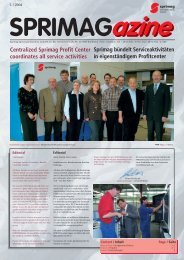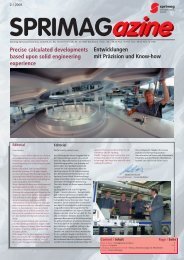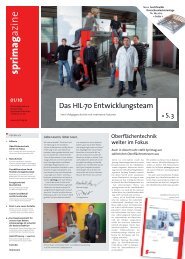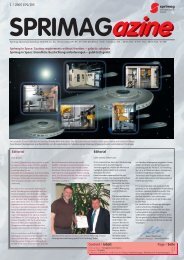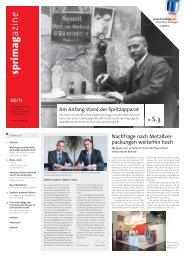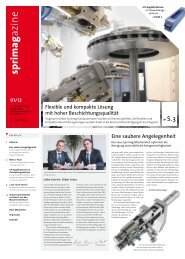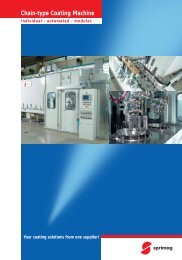Ich weiß, dass ich nichts weiß (Sokrates) ...aber ich weiß ... - Sprimag
Ich weiß, dass ich nichts weiß (Sokrates) ...aber ich weiß ... - Sprimag
Ich weiß, dass ich nichts weiß (Sokrates) ...aber ich weiß ... - Sprimag
Sie wollen auch ein ePaper? Erhöhen Sie die Reichweite Ihrer Titel.
YUMPU macht aus Druck-PDFs automatisch weboptimierte ePaper, die Google liebt.
4<br />
Anti-Friction Coatings<br />
conquer applications in<br />
automotive industry<br />
The pressure in the automotive industry for<br />
higher quality and increased reliability also<br />
motivates the component suppliers to<br />
enter new paths. As a result, more and<br />
more antifriction coatings are finding new<br />
applications in the automotive industry.<br />
A major automotive supplier, and leading<br />
supplier of high-quality AC systems for<br />
cars, manufactures their own compressors.<br />
To meet the request for improved compressors,<br />
a newly developed compressor<br />
type will be produced starting this year. In<br />
this compressor type, the swash plate is<br />
coated with an anti-friction coating. The<br />
swash plate is the part on wh<strong>ich</strong> the pistons<br />
of the compressor slide, by way of its<br />
“wobbling” movement, thus creating the<br />
piston stroke.<br />
The order for the supply of the swash plate<br />
coating plant was given to <strong>Sprimag</strong> Inc.,<br />
Cincinnati (USA), a subsidiary of <strong>Sprimag</strong><br />
Spritzmaschinenbau GmbH & Co. KG,<br />
Kirchheim/Teck. The scope of supply<br />
consists of a pretreatment section, the<br />
coating plant with driers, paint kitchen and<br />
air make-up unit, the curing ovens, as well<br />
the complete automatic interlinkage<br />
between the sections.<br />
The job was executed by an international<br />
project team consisting of engineers of<br />
<strong>Sprimag</strong> Inc. and <strong>Sprimag</strong> Spritzmaschinenbau.<br />
To reduce delivery times the cleaning<br />
machine and the oven section were manu-<br />
factured and commissioned in the USA,<br />
while the coating plant was manufactured<br />
and tested in the main factory in Germany.<br />
This also means that the single plant sections<br />
and its interaction could only be<br />
tested as a complete system during the<br />
commissioning at the customer's plant.<br />
Therefore, a coordination of the interfaces<br />
and the delivery dates was necessary to<br />
meet the fixed final date, hence confirming<br />
the customer's confidence in <strong>Sprimag</strong>'s<br />
capabilities. A challenge wh<strong>ich</strong> the <strong>Sprimag</strong><br />
team successfully passed. The coating task<br />
itself was also a challenge for the <strong>Sprimag</strong><br />
engineers. The swash plate is an assymetrical<br />
cylinder. This means in top view the<br />
plate is not a circle but an ellipse. The<br />
surface again has only to be coated partially<br />
from above and below on the outer section<br />
of the ellipse, along the raceway of the<br />
piston, while no coating in the inner area is<br />
allowed. The border of the coating had to<br />
be very sharp. Maskings should not be<br />
used, so as to reduce cleaning work and<br />
down time. A parallel movement of top and<br />
bottom surface of the raceway caused an<br />
additional challenge of the task. In practice,<br />
an optimization for one surface always had<br />
a contrary effect to the other surface.<br />
Again, <strong>Sprimag</strong> showed its high flexibility<br />
due to its process knowledge and past<br />
portfolio of spray technology. The solution<br />
was a new development of a special nozzle,<br />
wh<strong>ich</strong> allows itself to come close to the surface<br />
while at the same time able to reduce<br />
the spray mist at the peripherals. This allowed<br />
<strong>Sprimag</strong> to realize the maskless coating<br />
of the upper raceway with an additional<br />
Cleaning machine and oven section / Reinigungsanlage und Besch<strong>ich</strong>tungszone<br />
swivel movement of the spray gun. Due to<br />
the contrary relation between top and bottom<br />
surface, the work-piece holder had to<br />
be used as a mask to perform the coating<br />
on the bottom raceway. However, with<br />
integration of an additional cleaning station<br />
to periodically clean the work-piece holders,<br />
<strong>Sprimag</strong> was able to realize a significant<br />
increase in the operational time of the<br />
holders.<br />
The complete process consists of the part<br />
cleaning, the coating of the part with drying<br />
and the curing process. The parts are<br />
loaded manually with a defined orientation<br />
at the cleaning machine. To verify if the<br />
parts are correctly loaded, an additional<br />
check is done at the part inlet. After the<br />
check, the parts passing through an alkaline<br />
spray cleaning with following rinse stages.<br />
The drying is performed by a hot air recirculation<br />
blow-off. After cleaning, the parts<br />
are transferred by an automatic Pick &<br />
Place-Handling from the cleaning machine<br />
to the chain conveyor of the coating<br />
machine. Here the spindles of the chain<br />
Projects<br />
conveyor are aligned prior to the transfer to<br />
allow an oriented loading of the parts at the<br />
loading position.<br />
The coating zone consists of 3 driers, wh<strong>ich</strong><br />
are operated and controlled separately, and<br />
a combined spray cabin with 2 spray<br />
stations, each equipped with a separate<br />
exhaust. After, the swash plates are transferred<br />
onto the coating conveyor, the parts<br />
pass through a preheating zone and arrive<br />
at the first spray cabin where the first layer<br />
is applied. The coating process takes place<br />
in several spray stations. For the spraying<br />
process the<br />
spindles are<br />
rotated by a<br />
friction drive.<br />
In order to<br />
minimize the<br />
influence of the<br />
tumbling motion<br />
of the spindles<br />
on the coating<br />
process, spindles<br />
are additionally<br />
fixed at the<br />
spray stations.<br />
The spray guns<br />
are mounted to<br />
a swivel axis<br />
driven by servomotors.<br />
Thus, a<br />
defined swivel<br />
movement of<br />
the spray guns<br />
is achieved, and the velocity of the movement<br />
can be controlled. The spray guns<br />
themselves are attached to precision cross<br />
slides, enabling on reassemblies an easy<br />
reproduction of the spray guns' position.<br />
After the first coating process, the parts<br />
pass through an intermediate drier and<br />
reach the second spray station, where the<br />
coating process is repeated. Then again,<br />
the parts pass a drier and finally reach the<br />
measuring station, integrated in the coating<br />
plant for inline-process monitoring.<br />
The coating layer thickness is gauged within<br />
cycle time and compared to limit values by<br />
a non-contact metering system. Parts not<br />
matching the predetermined range of layer<br />
thicknesses are sorted out, and automatically<br />
ejected. Correct parts are automatically<br />
discharged from the chain by a Pick &<br />
Place-Handling and transferred to the<br />
conveyor of the curing zone. For this reason,<br />
parts are aligned again and spindles are<br />
fixed at the transfer zone.<br />
The curing zone consists of several inline<br />
oven zones followed by a cooling zone. The<br />
oven zones can be controlled separately<br />
and allow heating of the parts in steps up<br />
to the curing temperature of the paint.<br />
After the curing process, the parts are cooled<br />
down inside a cooling zone and then<br />
discharged manually. In order to avoid that<br />
parts remain on the conveyor and being<br />
transported back, the holders are checked<br />
automatically to ensure they are empty.<br />
To prevent contamination of the parts<br />
during the process flow, the transfer areas<br />
are enclosed and supplied with conditioned<br />
fresh air. The spray cabin, too, is supplied<br />
with conditioned air, in order to reach<br />
reproducible process conditions. To reduce<br />
the exhaust air flow the booth air is<br />
recirculated and only a partial air volume<br />
is exhausted. This reduced exhaust air<br />
volume allows the post-combustion unit to<br />
be designed smaller and operated more<br />
efficiently due to the higher concentration<br />
of solvents in the exhaust air.<br />
With this project <strong>Sprimag</strong> once again<br />
proved its competence, and showed that<br />
with its process knowledge and technology<br />
portfolio <strong>Sprimag</strong> is able to design and<br />
supply complex systems and processes that<br />
meet customers' fullest satisfaction.<br />
please contact:<br />
martin.grau@sprimag.de<br />
or joseph.vanden-eynden@sprimag.com<br />
Gleitlacke und ihre<br />
Anwendungen in der<br />
Automobilindustrie<br />
Der Druck in der Automobilindustrie nach<br />
höherer Qualität und Zuverlässigkeit fordert<br />
auch die Zulieferer auf, neue Wege zu<br />
gehen. Gleitlacke finden aus diesem Grunde<br />
zunehmend neue Anwendungen im Bere<strong>ich</strong><br />
der Automobilindustrie. Ein bedeutender<br />
Zulieferer der Automobilindustrie und führender<br />
Hersteller von hochwertigen Klimaanlagen<br />
für Kraftfahrzeuge fertigt seine<br />
eigenen Kompressoren für Klimaanlagen.<br />
Um der Nachfrage nach hochwertigen<br />
Kompressoren gerecht zu werden, wird ab<br />
diesem Jahr ein zusätzl<strong>ich</strong>er Kompressorentyp<br />
gefertigt. Für diesen Kompressorentyp<br />
wird die Taumelscheibe, auf welcher die<br />
Kolben des Kompressors gleiten und durch<br />
deren Taumelbewegung entsprechend der<br />
Kolben-hub bewirkt wird, mit einem<br />
Gleitlack besch<strong>ich</strong>tet.<br />
Den Auftrag für die Lieferung der<br />
Besch<strong>ich</strong>tungsanlage für die Taumelscheibe<br />
erhielt <strong>Sprimag</strong> Inc., Cincinnati (USA). Der<br />
Lieferumfang umfasste eine Teilevorreinigung,<br />
die Besch<strong>ich</strong>tungsanlage mit<br />
Trocknern, Farbraum und Zuluftanlage, die<br />
Einbrennöfen sowie die komplette automatische<br />
Verkettung der Zonen miteinander.<br />
Die Auftragsabwicklung erfolgte mit einem<br />
internationalen Projektteam bestehend aus<br />
<strong>Sprimag</strong>-Mitarbeitern aus Deutschland<br />
und aus den USA. Zur Reduzierung der<br />
Liefer-zeiten wurden die Reinigungsanlage<br />
sowie die Ofenzone in den USA hergestellt<br />
und in Betrieb genommen, während die<br />
Besch<strong>ich</strong>-tungsanlage selbst im<br />
Stammwerk in Deutschland gefertigt und<br />
in Betrieb genommen wurde. Dies wiederum<br />
bedeutete, <strong>dass</strong> die einzelnen Anlagenteile<br />
sowie deren Zusammenspiel erst bei der<br />
Inbetrieb-nahme im Kundenwerk als Gesamtes<br />
getestet werden konnten. Hierzu<br />
war eine detaillierte Abstimmung der<br />
Schnittstellen als auch der Liefertermine<br />
erforderl<strong>ich</strong>, um den fixen Endtermin halten<br />
zu können, sowie ein Höchstmaß an Vertrauen<br />
durch den Kunden in <strong>Sprimag</strong>s<br />
Leistungsfähigkeit. Eine Herausforderung



